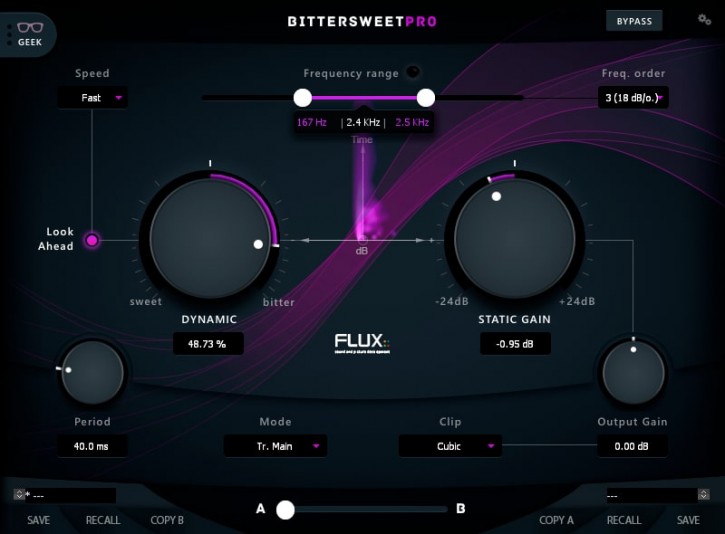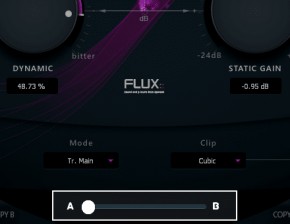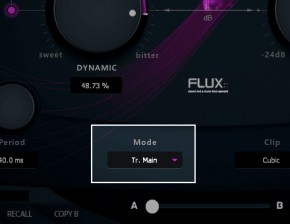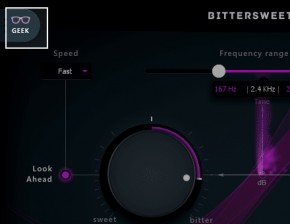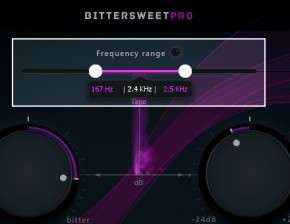Flux:: Solera v3
Hersteller: Flux::
Weitere Informationen:
http://www.flux.audio/project/solera/
169,00 CHF
Produktbeschreibung
Mastering the art of dynamics
Solera v3 is a comprehensive full band dynamics processor combining the power of a compressor, expander, de-compressor and de-expander, all four processing in parallel, designed to provide powerful dynamics processing for any challenging situation and still preserve, or recover, the true natural quality of the audio material without adding any artifacts.
Comprehensive full band dynamics processing, powerful natural dynamics processing, preserve or recover the natural quality of the audio material without adding artifacts.
All Features
Up to 8 channels Input/Output
Generous -/+ 48 dB input/output gain range
Input/Output gain controls for adjusting the levels before and after processing
Dry/wet control offering true parallel dynamics processing and for blending some of the original “peak” into the processed signal
Advanced detection and analysis
To perform the most detailed analysis of the material possible, a side chain section featuring a three-band equalizer for generating true frequency sensitive processing, as well as input options for an external sidechain signal, is provided.
Side Chain Section Details
Each of the three eq-bands provides; Gain, Frequency and Q-Factor, as well as five different Filter Types:
12 dB per octave high pass filter
Low shelving
Parametric
High shelving
12 dB per octave low pass filter
The external side-chain input is available in AU (Mac OS X) and AAX Native & DSP (Mac OS X & Windows) only.
Full control over the processing
In addition to the common controls on a dynamics processor; ratio, attack, release, Solera offers control over the fundamental characteristics of the dynamics processing, all in order to provide full control over the processing even in the most demanding situations.
Details:
Envelope, Time and Detection Settings
Extended envelope settings with full control of Attack, Hold and Release with Manual, Auto and Advanced release modes.
Zero attack time for the dynamics processing by introducing a delay reflecting the attack time into the signal path.
Eight different detection modes interacting with the time and envelope settings as well as with the integration times for the RMS detection. Includes specific “Feed Backward” modes inspired by vintage hardware architectures for producing a naturally “beefy” sound.
Dynamic Factor – Amplifies or diminishes the extracted real-time dynamics information.
Dynamic Velocity – Controls the speed of variation on t
Open up the sound and increase the dynamic impression
On each of the four dynamics processing sections two parameters are provided that are kind of unique to dynamics processing; Dynamics Ratio and Level Independent Detection (L.I.D), using the dynamic range content of the signal and not just the signal levels as standard processors do.
Details:
Dynamics Ratio is controlling the amount of auto-ratio determined by the signal dynamics and the manual ratio setting. This literally opens the sound, increases the dynamic impression and keeps some crest by adjusting, in real time, the ratio of every dynamic processing section in regards to both the current ratio settings and the signal content (mainly dynamic range).
Level Independent Detection (L.I.D) controls the amount of auto-threshold determined by the signal dynamics and the manual threshold value, providing processing of the audio signal independently of the sound level and instead in regards to the signal dynamic range.
A Maximum mode can be engaged on the L.I.D control, allowing for processing that accounts for the maximum values of both the standard and the L.I.D detection schemes.
Control the Stereo width of your mix
To control the actual Stereo width of the mix a built-in MS encoder/decoder is used to split the stereo-signal in its M and S components in order to control the actual stereo width of the mix.
Details:
The MS Width Control – Sets the stereo width of the processed signal. A -6 dB value deceases the stereo width. A +6 dB value increases the wideness of the stereo mix but can produce phase issue.
The MS Mode Control – Enables one MS encoding matrix at the input and one MS decoding matrix at the output of the dynamic processing in order to control the stereo width of the mix. When engaged, the side chain is fed by a MS encoded signal that is reflected in the display section. M channel corresponds to the normal left channel. And the S channel corresponds to the normal right channel.
(This feature is only available when two channels (no more, no less) are processed.)
Dual Preset Slots and Parameter Morphing
The built in preset manager and the preset morphing slider, provides instant and intuitive control of all parameters and controls. In a second, with a simple one-click operation, everything is copied from one of the two preset slots to the other, even during playback.
The two Preset/Parameter slots, A and B, can be loaded with two full set of parameters at the same time, and except for only A/B comparing two sets of parameters, the morphing slider will allow to mix them, and to record the morph with the host automation.
Individual Multichannel Processing
Up to eight channels of simultaneous processing for multichannel surround configuration is provided. The processing can be disengaged on any of the channels leaving the material unprocessed, bypassing the original sound.
When operating on a multi-channel bus all, up to eight in total, channels are processed by default, though the processing can be disengaged for any number of channels leaving the material unprocessed and bypassing the original sound.
By doing this in combination with serial instances the material on any number of channels can be processed with individual settings.
Specifications
Availability
Solera v3 is available in:
AU / VST / AAX Native / AAX DSP / AAX AudioSuite / Waves WPAPI
Merging VS3 MassCore/Native for Pyramix 10/11 & Ovation 6/7 **
Processing
Solera v3, as all Flux:: plug-ins, provide
Up to 8 channels Input/Output.
64-bits internal floating point processing.
Sampling rate up to 384 kHz DXD (Pyramix & Ovation MassCore/Native)**
Sampling rate up to 192 kHz for Native (AU/VST/AAX/AAX AudioSuite).
Hardware Requirements
A graphic card fully supporting OpenGL 2.0 is required.
Mac OS X: OpenGL 2.0 required – Mac Pro 1.1 & Mac Pro 2.1 are not supported.
Windows: If your computer has an ATi or NVidia graphics card, please assure the latest graphic drivers from the ATi or NVidia website are installed.
Software Licence Requirements
In order to use the software an iLok.com user account is required (the iLok USB Smart Key is not required).
Compatibility
All major native formats are supported
Windows – 7 SP1, 8.1 and 10, all in 64 bits only.
VST (2.4)
AAX Native*
AAX AudioSuite*
Waves WPAPI
Merging VS3 (Only in Windows 7 64 bits)**
Mac OS X (Intel) – All versions from 10.7.5 (64bit only)
VST (2.4)
AU
AAX Native*
AAX AudioSuite*
Waves WPAPI
* AAX Native & AAX AudioSuite in Pro Tools 11 and 12
** VS3 license not included in Flux:: standard license. Additional VS3 Native/MassCore license for Pyramix 10/11 & Ovation 6/7 is available from Merging Technologies: http://www.merging.com/sales
Due to AVID ProTools changing to AAX, from Version 3 (v3) RTAS for AVID ProTools is no longer supported.
Weitere Informationen: http://www.flux.audio/project/solera/
Bewertungen

